Hoffman D.M., Singh B., Thomas J.H. (Eds). Handbook of Vacuum Science and Technology
Подождите немного. Документ загружается.


380
Chapter 3.4: Mass Flow Measurement and Control
tube in laminar flow is related to tht fourth power of diameter. For the level of
flow accuracy desired for these instruments, better than 1%, the mechanical toler-
ances are effectively unachievable unless calibration is performed after assembly
of the individual sensor and bypass combination.
3.4.2.3
Control Valve Design
The sensor, associated electronics, and bypass (where one is needed) form a mass
flow meter. To make the instrument a mass
flow
controller,
a
control valve is placed
downstream from the meter and a control circuit is added to the electronics. Con-
trol valves used in typical MFCs allow continuous adjustment of the conductance
as opposed to the on/off action of a shutoff valve. The resolution of conductance
is much better than 0.1% of the open conductance to obtain the desired control
range of the MFC. Generally, the control valve is not capable of providing posi-
tive
shutoff,
and a separate valve intended for that purpose should be used. The
valve's open conductance can be set by selecting the orifice diameter and, as with
the bypass, is determined by the full-scale range of the MFC. Two varieties of
control valves are in common
use:
solenoid actuated and piezoelectric actuated.
Solenoid valve designs are more traditional and more commonly used in MFCs.
An overview of the typical construction of a solenoid valve is shown in Figure 3.
The operating principle relies on current in the solenoid to generate a magnetic
field that acts on the armature to open the valve. A flat spring is normally under
Fig.
3.
Coil
Magnetic
Armature
Orifice
Solenoid valve overview.
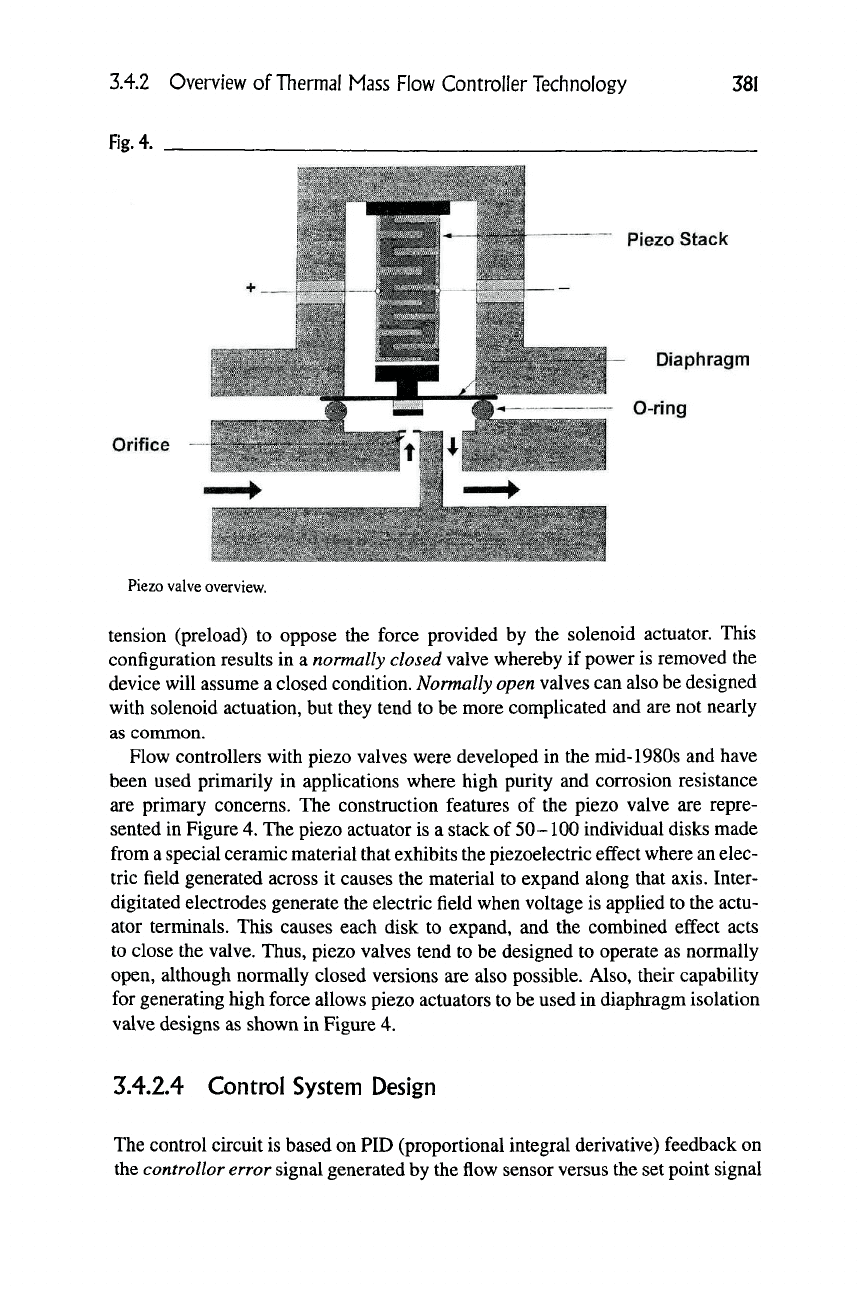
3.4.2 Overview of Thermal Mass Flow Controller Technology
381
Fig.
4.
Orifice
Piezo valve overview.
tension (preload) to oppose the force provided by the solenoid actuator. This
configuration results in a normally closed valve whereby if power is removed the
device will assume a closed condition. Normally open valves can also be designed
with solenoid actuation, but they tend to be more complicated and are not nearly
as common.
Flow controllers with piezo valves were developed in the mid-1980s and have
been used primarily in applications where high purity and corrosion resistance
are primary concerns. The construction features of the piezo valve are repre-
sented in Figure 4. The piezo actuator is a stack of 50-100 individual disks made
from a special ceramic material that exhibits the piezoelectric effect where an elec-
tric field generated across it causes the material to expand along that axis. Inter-
digitated electrodes generate the electric field when voltage is applied to the actu-
ator terminals. This causes each disk to expand, and the combined effect acts
to close the valve. Thus, piezo valves tend to be designed to operate as normally
open, although normally closed versions are also possible. Also, their capability
for generating high force allows piezo actuators to be used in diaphragm isolation
valve designs as shown in Figure 4.
3.4.2.4
Control System Design
The control circuit is based on PID (proportional integral derivative) feedback on
the controllor error signal generated by the flow sensor versus the set point signal

382 Chapter 3.4: Mass Flow Measurement and Control
supplied to the MFC. Note that the controUor error is simply the instantaneous
difference between the flow signal and the set point; it should not be confused
with the overall instrument error, which is represented by the difference between
the flow signal and the actual flow. The control action is tuned to drive the valve
so that the controller error is reduced to zero as rapidly as possible with little or
no overshoot. Tuning involves changing parameters governing the action of the
PID gains to achieve the desired response to set point changes. The tuning can
be optimized for a given set of conditions such as gas type, upstream pressure,
downstream pressure, physical orientation, and set point; but if the conditions
change significantly, controller performance may be affected. Symptoms are typ-
ically slow response to set point changes or control oscillation.
3.4.3
PERFORMANCE CHARACTERISTICS
The proper installation procedure, gas line components, and ancillary electronic
instrumentation help ensure optimal performance and reliability from an MFC.
Environmental conditions such as temperature, orientation, vibration, and electro-
magnetic interference may also affect an MFC's ability
to
measure and control flow.
3.4.3.1
Installation
For all gas line components including the MFC, the proper fittings and mechani-
cal installation are necessary to provide a leak-tight system. The fittings on most
MFCs are either face seal (VCR®, registered TM of Cajon Co., Macedonia, OH)
or ferrule seal (Swagelock®, registered TM of Crawford Fitting Co., Solon, OH)
for
j-inch
pipe. However, if the full-scale flow is greater than 20 slm, the fittings
may be for ^-inch pipe. For vacuum system or high-purity applications, the MFC
fittings should be helium leak tested if possible. This is extremely important in
the case of toxic or corrosive gas service. In addition to ensuring the leak integrity
of the system, proper purging to reduce atmospheric contamination (moisture and
oxygen) to acceptable trace levels is crucial for reliable performance. The specific
method to achieve this condition depends on the system and level of contamina-
tion desired. At a particular facility, standard purging procedures should be estab-
lished for each case. Likewise, procedures for removing the toxic or corrosive gas
before removing an MFC (or any other gas line component) must be established
and followed.

3.4.3 Performance Characteristics
383
After the recommended warmup period, a check of the indicated zero is advis-
able.
The user's manual for the particular instrument should be consulted regard-
ing the proper procedure, but in general, the following guidelines may be used:
• Ensure there is no flow by closing a separate shutoff valve in line with the
MFC.
• Command a set point flow to the MFC. (This equalizes the pressure upstream
to downstream.)
• After the indicated flow has stabilized, command a set point flow of zero.
• Adjust the potentiometer, usually accessible from the outside of the instru-
ment, labeled "zero."
• Alternatively, the adjustment may be performed at the readout/set point
device.
This process avoids the problem of "zeroing in" a small leak, which may nor-
mally occur through the MFC control valve while a differential pressure remains
across the MFC during the zero adjustment.
3.4.3.2 Gas Line Components
In line with the MFC is often a combination of other instruments and components
including a pressure regulator, a particle filter, shutoff
valves,
and a pressure trans-
ducer. In some industries, such as semiconductor manufacturing, this is called a
gas stick. A typical gas stick layout is shown in Figure 5. The pressure regulator
and filter can affect MFC performance if a fluctuation in pressure occurs or if the
differential pressure becomes too low or too high.
3.4.3.3 Electrical Requirements
The electrical connector on an MFC is usually either a "card edge," 15-pin D, or
9-pin D. The D connectors provide a degree of electromagnetic shielding when
Fig.
5.
Inlet
Pressure
Regulator
Shutoff Filter
Valve
Shutoff
Valve
Outlet
Typical gas stick.
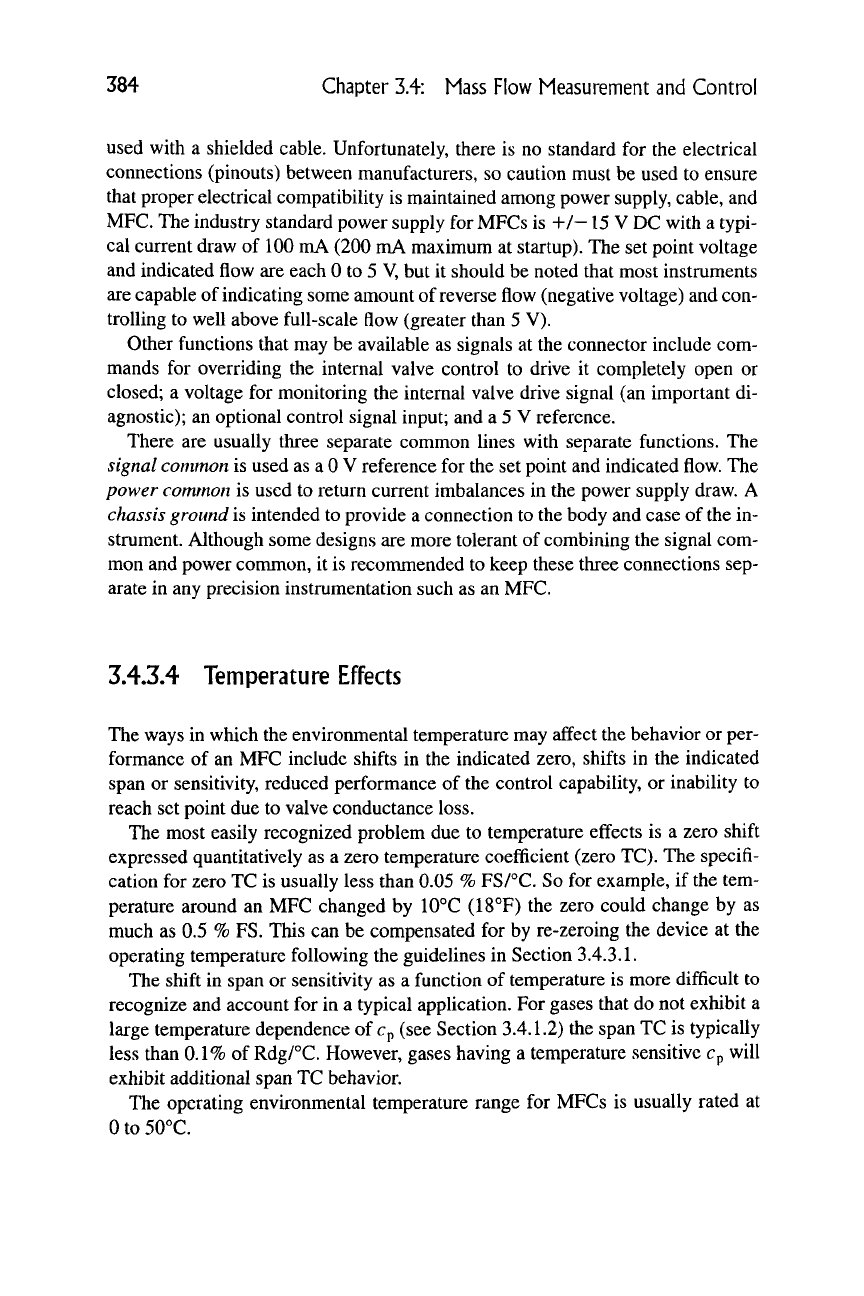
384 Chapter 3.4: Mass Flow Measurement and Control
used with a shielded cable. Unfortunately, there is no standard for the electrical
connections (pinouts) between manufacturers, so caution must be used to ensure
that proper electrical compatibility is maintained among power supply, cable, and
MFC.
The industry standard power supply for MFCs is +/—
15
V DC with a typi-
cal current draw of 100 mA (200 mA maximum at startup). The set point voltage
and indicated flow are each 0 to 5 V, but it should be noted that most instruments
are capable of indicating some amount of reverse flow (negative voltage) and con-
trolling to well above full-scale flow (greater than 5 V).
Other functions that may be available as signals at the connector include com-
mands for overriding the internal valve control to drive it completely open or
closed; a voltage for monitoring the internal valve drive signal (an important di-
agnostic); an optional control signal input; and a 5 V reference.
There are usually three separate common lines with separate functions. The
signal common is used as a 0 V reference for the set point and indicated flow. The
power common is used to return current imbalances in the power supply draw. A
chassis ground is intended to provide a connection to the body and case of the in-
strument. Although some designs are more tolerant of combining the signal com-
mon and power common, it is recommended to keep these three connections sep-
arate in any precision instrumentation such as an MFC.
3.4.3.4 Temperature Effects
The ways in which the environmental temperature may affect the behavior or per-
formance of an MFC include shifts in the indicated zero, shifts in the indicated
span or sensitivity, reduced performance of the control capability, or inability to
reach set point due to valve conductance loss.
The most easily recognized problem due to temperature effects is a zero shift
expressed quantitatively as a zero temperature coefficient (zero TC). The specifi-
cation for zero TC is usually less than 0.05 % FS/°C. So for example, if the tem-
perature around an MFC changed by 10°C (18°F) the zero could change by as
much as 0.5 % FS. This can be compensated for by re-zeroing the device at the
operating temperature following the guidelines in Section
3.4.3.1.
The shift in span or sensitivity as a function of temperature is more difficult to
recognize and account for in a typical application. For gases that do not exhibit a
large temperature dependence of
Cp
(see Section 3.4.1.2) the span TC is typically
less than
0.1%
of Rdg/°C. However, gases having a temperature sensitive c^ will
exhibit additional span TC behavior.
The operating environmental temperature range for MFCs is usually rated at
0 to 50°C.
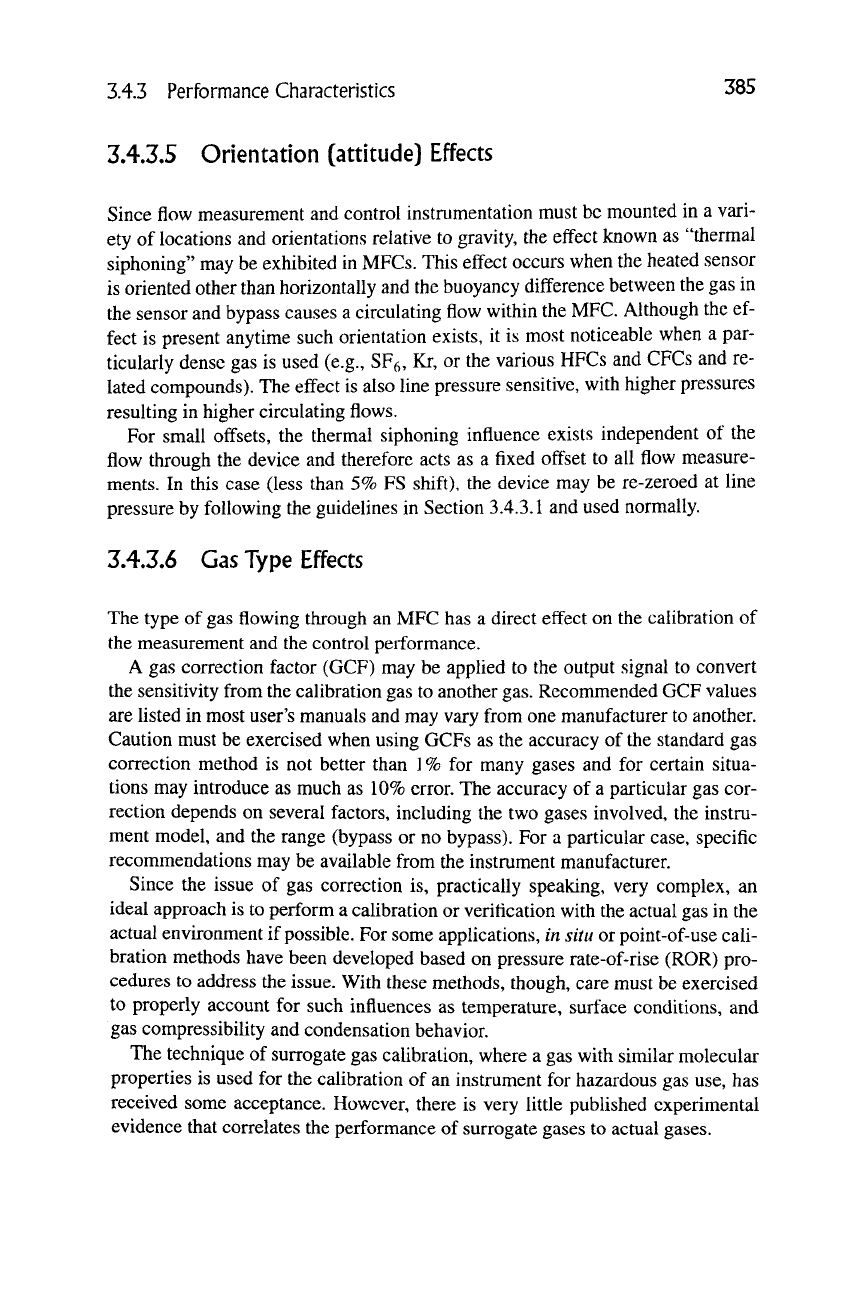
3.4.3 Performance Characteristics
385
3A3.5 Orientation (attitude) Effects
Since flow measurement and control instrumentation must be mounted in a vari-
ety of locations and orientations relative to gravity, the effect known as "thermal
siphoning" may be exhibited in MFCs. This effect occurs when the heated sensor
is oriented other than horizontally and the buoyancy difference between the gas in
the sensor and bypass causes a circulating flow within the MFC. Although the ef-
fect is present anytime such orientation exists, it is most noticeable when a par-
ticularly dense gas is used (e.g., SF6, Kr, or the various MFCs and CFCs and re-
lated compounds). The effect is also line pressure sensitive, with higher pressures
resulting in higher circulating flows.
For small offsets, the thermal siphoning influence exists independent of the
flow through the device and therefore acts as a fixed offset to all flow measure-
ments. In this case (less than 5% FS shift), the device may be re-zeroed at line
pressure by following the guidelines in Section 3.4.3.1 and used normally.
3.4.3.6 Gas Type Effects
The type of gas flowing through an MFC has a direct effect on the calibration of
the measurement and the control performance.
A gas correction factor (GCF) may be applied to the output signal to convert
the sensitivity from the calibration gas to another gas. Recommended GCF values
are listed in most user's manuals and may vary from one manufacturer to another.
Caution must be exercised when using GCFs as the accuracy of the standard gas
correction method is not better than \% for many gases and for certain situa-
tions may introduce as much as 10% error. The accuracy of a particular gas cor-
rection depends on several factors, including the two gases involved, the instru-
ment model, and the range (bypass or no bypass). For a particular case, specific
recommendations may be available from the instrument manufacturer.
Since the issue of gas correction is, practically speaking, very complex, an
ideal approach is to perform a calibration or verification with the actual gas in the
actual environment if
possible.
For some applications, in situ or point-of-use cali-
bration methods have been developed based on pressure rate-of-rise (ROR) pro-
cedures to address the issue. With these methods, though, care must be exercised
to properly account for such influences as temperature, surface conditions, and
gas compressibility and condensation behavior.
The technique of surrogate gas calibration, where a gas with similar molecular
properties is used for the calibration of an instrument for hazardous gas use, has
received some acceptance. However, there is very litde published experimental
evidence that correlates the performance of surrogate gases to actual gases.
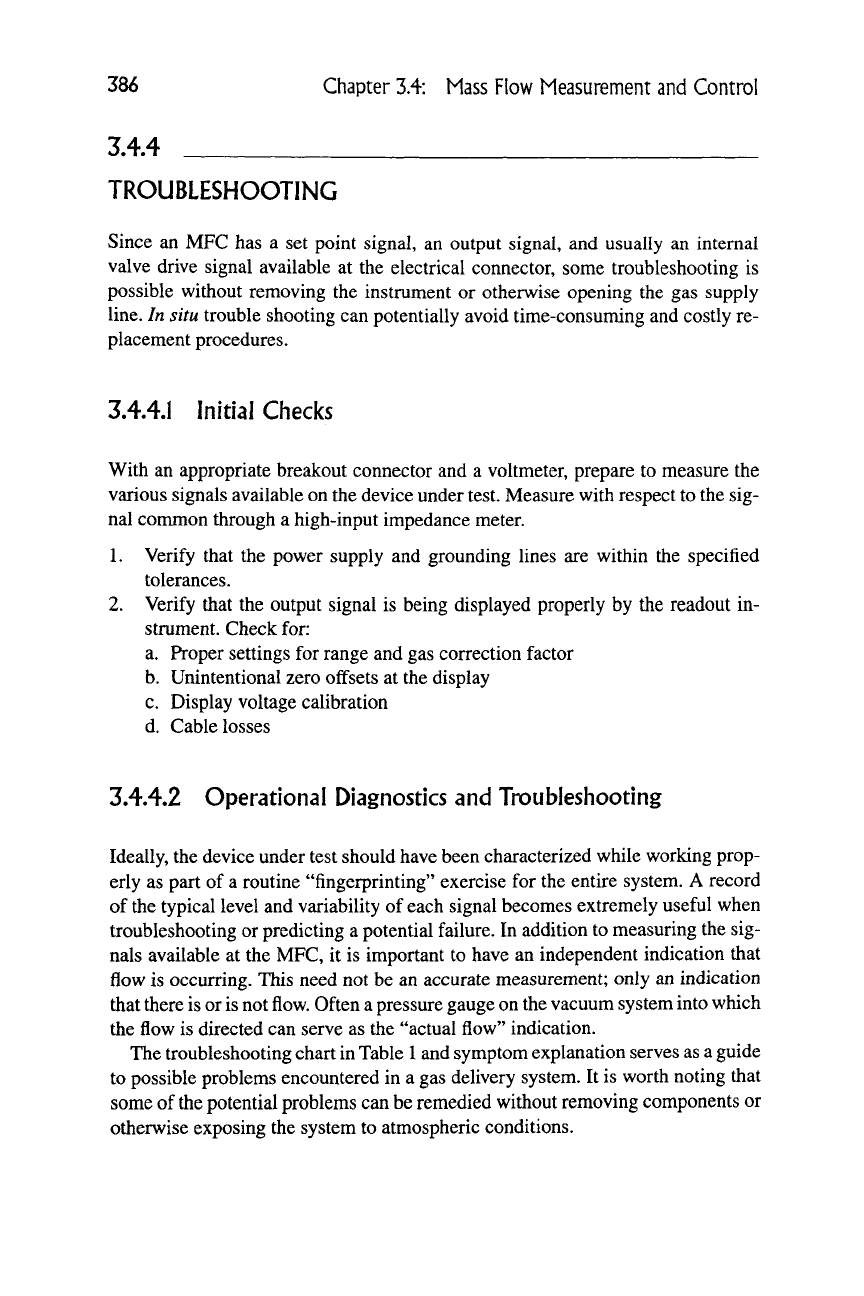
386 Chapter
3.4:
Mass Flow Measurement
and
Control
3.4.4
TROUBLESHOOTING
Since an MFC has a set point signal, an output signal, and usually an internal
valve drive signal available at the electrical connector, some troubleshooting is
possible without removing the instrument or otherwise opening the gas supply
line.
In situ trouble shooting can potentially avoid time-consuming and costly re-
placement procedures.
3.4.4.1
Initial Checks
With an appropriate breakout connector and a voltmeter, prepare to measure the
various signals available on the device under test. Measure with respect to the sig-
nal common through a high-input impedance meter.
1.
Verify that the power supply and grounding lines are within the specified
tolerances.
2.
Verify that the output signal is being displayed properly by the readout in-
strument. Check for:
a. Proper settings for range and gas correction factor
b.
Unintentional zero offsets at the display
c. Display voltage calibration
d. Cable losses
3.4.4.2
Operational Diagnostics and Troubleshooting
Ideally, the device under test should have been characterized while working prop-
erly as part of a routine "fingerprinting" exercise for the entire system. A record
of the typical level and variability of each signal becomes extremely useful when
troubleshooting or predicting a potential failure. In addition to measuring the sig-
nals available at the MFC, it is important to have an independent indication that
flow is occurring. This need not be an accurate measurement; only an indication
that there is or is not
flow.
Often a pressure gauge on the vacuum system into which
the flow is directed can serve as the "actual flow" indication.
The troubleshooting chart in Table
1
and symptom explanation serves as a guide
to possible problems encountered in a gas delivery system. It is worth noting that
some of the potential problems can be remedied without removing components or
otherwise exposing the system to atmospheric conditions.
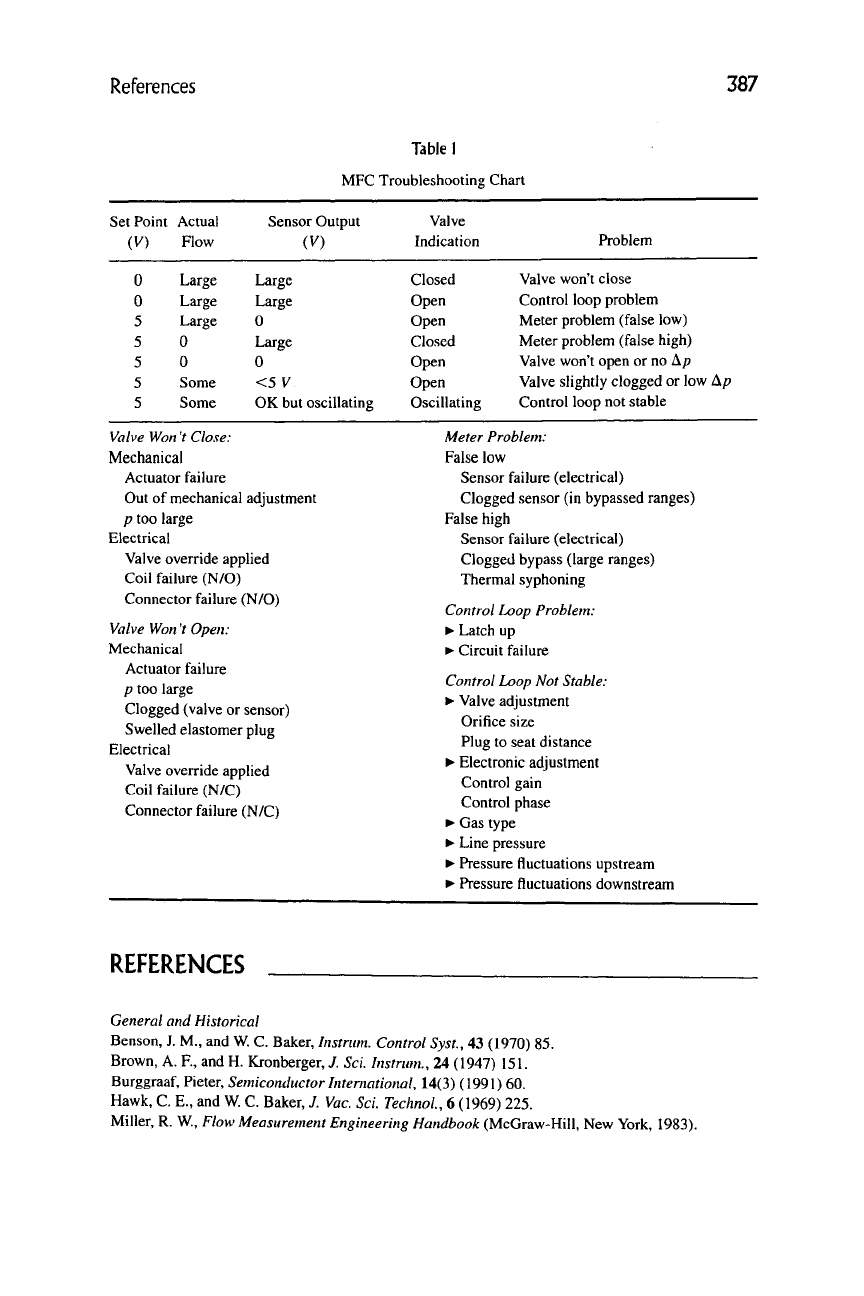
References
387
Table
1
MFC Troubleshooting Chart
Set Point
(V)
0
0
5
5
5
5
5
Actual
Flow
Large
Large
Large
0
0
Some
Some
Sensor Output
Large
Large
0
Large
0
<5V
OKbul
(V)
I
oscillating
Valve
Indication
Closed
Open
Open
Closed
Open
Open
Oscillating
Problem
Valve won't close
Control loop problem
Meter problem (false low)
Meter problem (false high)
Valve won't open or no Ap
Valve slighdy clogged or low A;?
Control loop not stable
Valve Won't
Close:
Mechanical
Actuator failure
Out of mechanical adjustment
p too large
Electrical
Valve override applied
Coil failure (N/O)
Connector failure (N/O)
Valve
Won't
Open:
Mechanical
Actuator failure
p too large
Clogged (valve or sensor)
Swelled elastomer plug
Electrical
Valve override applied
Coil failure (N/C)
Connector failure (N/C)
Meter Problem:
False low
Sensor failure (electrical)
Clogged sensor (in bypassed ranges)
False high
Sensor failure (electrical)
Clogged bypass (large ranges)
Thermal syphoning
Control Loop Problem:
• Latch up
• Circuit failure
Control Loop Not Stable:
• Valve adjustment
Orifice size
Plug to seat distance
• Electronic adjustment
Control gain
Control phase
• Gas type
• Line pressure
• Pressure
fluctuations
upstream
• Pressure
fluctuations
downstream
REFERENCES
General and Historical
Benson, J. M., and
W.
C. Baker,
Instrimi.
Control
Syst.,
43 (1970) 85.
Brown, A. E, and H. Kronberger,
J.
Sci.
Instrum.,
24 (1947) 151.
Burggraaf,
Pieter,
Semiconductor
International,
14(3) (1991) 60.
Hawk, C. E., and
W.
C. Baker,
J.
Vac.
Sci.
Technol.,
6 (1969) 225.
Miller, R. W., Flow
Measurement Engineering
Handbook (McGraw-Hill, New York, 1983).
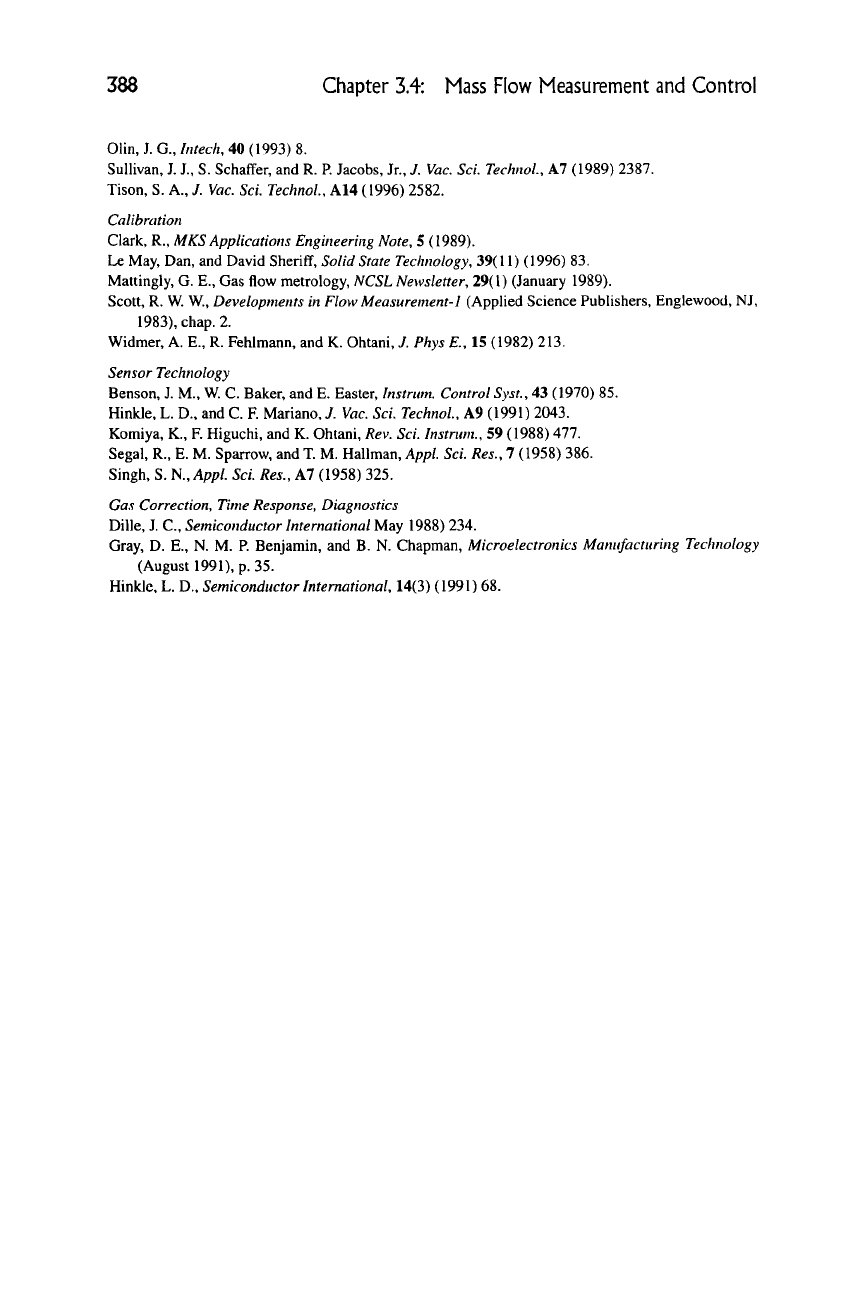
388 Chapter 3.4: Mass Flow Measurement and Control
Olin, J. G., Intecli, 40 (1993) 8.
Sullivan, J. J., S. Schaffer, and R. P. Jacobs, Jr., J.
Vac.
ScL Technol, A7 (1989) 2387.
Tison, S. A., y.
Vac.
Sci. Technoi, A14 (1996) 2582.
Calibration
Clark, R., MKS Applications Engineering Note, 5 (1989).
Le May, Dan, and David
Sheriff,
Solid State Technology, 39(11) (1996) 83.
Mattingly, G. E., Gas flow metrology, NCSL Newsletter, 29(1) (January 1989).
Scott, R. W. W., Developments in Flow Measurement-] (Applied Science Publishers, Englewood, NJ,
1983),
chap. 2.
Widmer, A. E., R. Fehlmann, and K. Ohtani, J. Phys E., 15 (1982) 213.
Sensor Technology
Benson, J. M., W. C. Baker, and E. Easter, Instrum. Control Syst., 43 (1970) 85.
Hinkle, L. D., and C. F. Mariano, J.
Vac.
Sci. Technoi, A9 (1991)
2043.
Komiya, K., F. Higuchi, and K. Ohtani, Rev. Sci. Instrum., 59 (1988) 477.
Segal, R., E. M. Sparrow, and T. M. Hallman, Appl Sci. Res., 1 (1958) 386.
Singh, S.
N.,
Appl. Sci. Res., A7 (1958) 325.
Gas Correction, Time Response, Diagnostics
Dille, J. C, Semiconductor International May 1988) 234.
Gray, D. E., N. M. P. Benjamin, and B. N. Chapman, Microelectronics Manufacturing Technology
(August 1991), p. 35.
Hinkle, L. D., Semiconductor International, 14(3) (1991) 68.
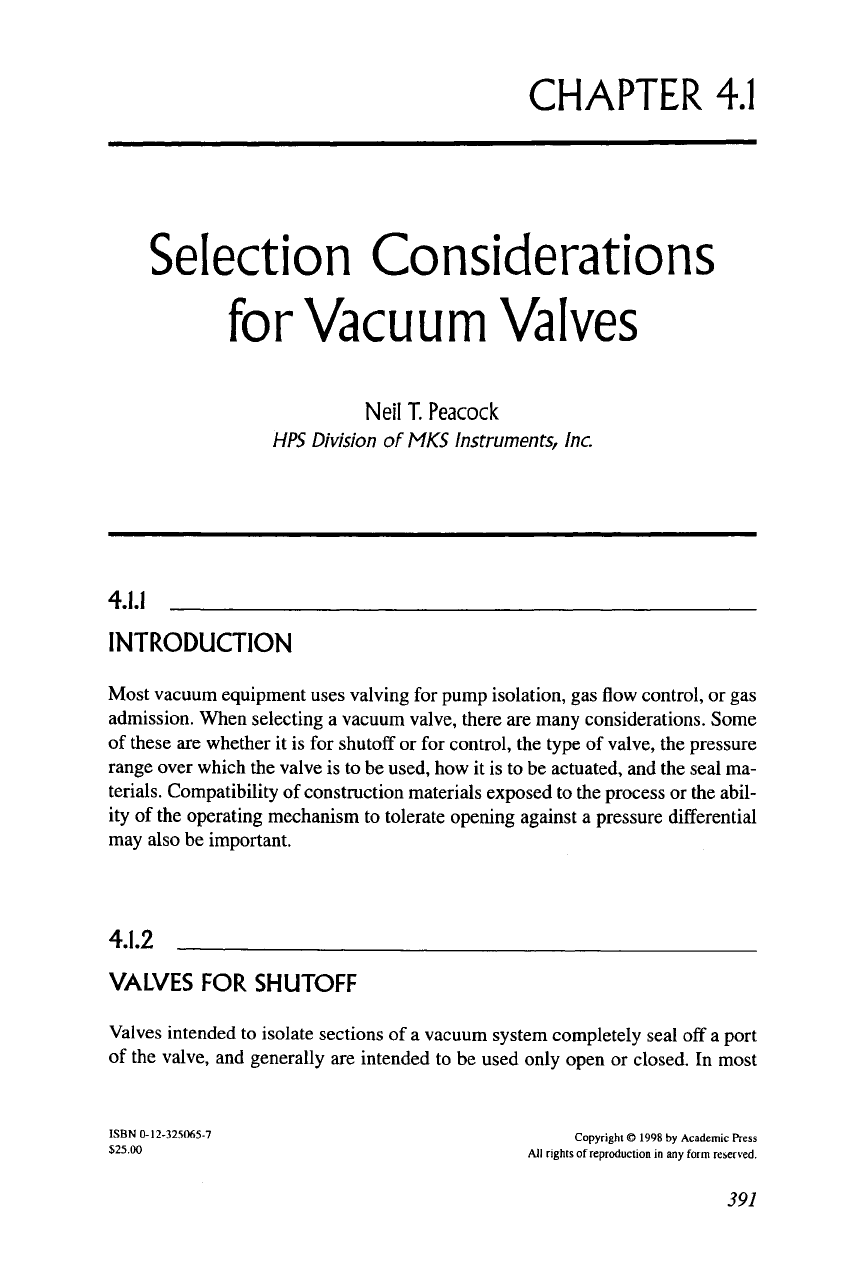
CHAPTER
4.1
Selection Considerations
for
Vacuum
Valves
Neil T. Peacock
MPS Division
ofMKS
Instruments,
Inc.
4.1.1
INTRODUCTION
Most vacuum equipment uses valving for pump isolation, gas flow control, or gas
admission. When selecting a vacuum valve, there are many considerations. Some
of these are whether it is for shutofif or for control, the type of
valve,
the pressure
range over which the valve is to be used, how it is to be actuated, and the seal ma-
terials. Compatibility of construction materials exposed to the process or the abil-
ity of the operating mechanism to tolerate opening against a pressure differential
may also be important.
4.1.2
VALVES FOR SHUTOFF
Valves intended to isolate sections of a vacuum system completely seal off a port
of the valve, and generally are intended to be used only open or closed. In most
ISBN 0-12-325065-7 Copyright © 1998 by Academic Press
^^^•^ All rights of reproduction in any form reserved.
391
